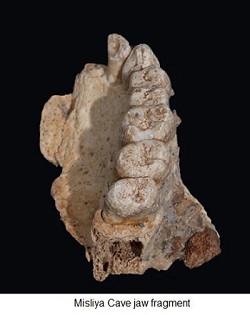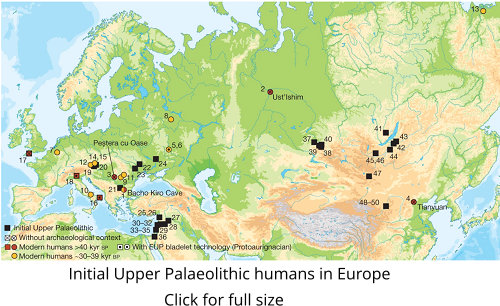Homo Sapiens
Modern humans are called Homo sapiens (man wise) and the oldest DNA from Homo sapiens fossils come from Europe. There are a number of sites in Africa where fossils thought to be Homo sapiens have been found but in all cases the fossil record is sparse and there has been no DNA analysis. We will go through a number of these African excavations and it will become apparent that without DNA confirmation the identification of fossils is highly subjective and speculative.
When you're looking for the origin of Homo sapiens Africa is the place to look. The Theory of Evolution outlines how chimpanzees evolved into humans and Africa is where the chimpanzees are! Starting from African chimpanzees mutations produced new specics over millions of years. Homo erectus evolved nearly two million years ago, followed by Homo heidelbergensis some 800,000 years ago. There are other human predecessors inbetween the two but Homo erectus is important because it is the first specics that is more human than chimpanzee. And Homo heidelbergensis is thought to be the specics that both Homo neanderthalensis and Homo spaiens evolved from.
DNA is a fragile molecule which degrades over time so the older a fossil is the more difficult it is to extract DNA. The wet, warm climate of Africa with its tropical and subtropical climate means DNA does not preserve well there. DNA specimens are obtained from very cold and dry environments and are best preserved in permafrost or frozen in caves. Thus we find the best evidence for the earliest Homo sapiens in Europe and Asia. The oldest DNA extracted was from a Siberian Woolly Mammoth one million years old with the mammoth's entire carcus deep frozen in the permafrost. The oldest DNA from a Neanderthal is dated 400,000 years ago and was found in a Spanish cave.
When we look at early modern Homo sapiens sites throughout Africa we find that all are based upon a very sparse fossil record without any DNA analysis and they are not really Homo sapien at all. Based upon the fossil record alone these fossils are labeled as Homo sapiens because they have a single aspect that is shared with modern Homo sapiens. While this does indicate that the evolution of Homo sapiens likely occured throughout Africa these mutations only record one small change that eventually became part of modern day Homo sapiens.
This chart is labeled as 'Early Modern Homo sapiens Sites' but just a casual reading shows that the fossils from these sites are nothing close to modern humans. An article by Dennis O'Neil at Palomar College reviews the assessments from these earliest African sites:
The oldest site listed at Omo 1 in Ethiopia, dated at 195,000 years ago, 'shows the beginnings of the skull changes that we associate with modern people.'
The 160,000 year old skull from the Herto Middle Awash site in Ethiopia 'seems to be at the early stages of this transition.'
The third oldest site at Laetoli, Tanzania listed at 120,000 years ago shows 'more advanced transitional forms.'
Evolutionary fossils showing some feature of a transition from archaic humans to modern humans is not what we're looking for.
The Border Cave in South Africa was inhabited over a long period of time, 250,000 years, and some 9 individuals have been identified from the fossil record which includes a partial cranium.
| 'The brain endocast (an internal cast of a hollow object), including its shape, organization and vascularization, show similarities with modern humans, whereas the bony labyrinth exhibits ancestral features found in both Homo erectus and modern humans.' |
Again we're looking at a transitional form, what is called an 'archaic human' which can mean any human predessessor all the way back to Homo erectus! Corraberating data from the cave does show some Homo sapien type behavior; indications that they used grass to make bedding and the burial of an infant with personal ornamentation (a perforated shell indicating a necklace.)
The Klasies River Caves in South Africa, dated at 90,000 years ago, provides perhaps the best indication of Homo sapiens in Africa. Over 40 bone fragments have been recovered including a fragmentary temporal bone and partial atlas (The atlas bone is the first cervical vertebrae connecting the skull to the spine.) The overall assesstment is that the fossil record from the Klasies River Cave is 'comparable to Levantine Early Modern, Neandertal and recent human vertebrae.' That's in the ballpark because the 'Levantine Early Modern' is referring to a site in the Mid-East which most agree represent an early form of Homo sapiens. And while the Klasies River Cave in South Africa fossils are 'comparable' to Qatzeh they are not identical.
The Skhul and Qafzeh sites are in Israel and are dated to 92,000. The Skhul Cave is near Mount Carmel and Qafzeh is a rock shelter near Nazareth. Just like the African sites neither have had DNA extracted and both consist of a sparse fossil record. At best we can say the remains from the Skhul Cave and the Qafzeh rock shelter exhibit a mix of traits found in archaic and modern humans. The brain case is similar to modern humans, but they possess typical Neanderthals attributes; heavy brow ridges and lack of a chin. Without DNA from we're left with a sparse fossil record and opinions can disagree.
| “For me, claiming these remains are Homo sapiens stretches the meaning of that term a bit,” Shea added. “These humans who lived between 50,000-300,000 years ago are a morphologically diverse bunch. Whenever we find more than a couple of them from the same deposits, such as at Omo Kibish and Herto in Ethiopia or Skhul and Qafzeh in Israel, their morphology is all over the place both within and between samples.” |

But a few kilometers from the Skhul Cave in Israel is the Misliya Cave (not listed on chart.)
The only fossil recovered from the Misliya Cave is an upper jaw fragment with 7 teeth attached and is dated to an incredible 194,000 years ago. Teeth change dramatically between different specis and is used as a key indicator when assessing the fossil record. With no DNA available and using only the jaw fragment the conclusion reached by the execavators is:
| The remains are unquestionably H. sapiens, says team member María Martinón-Torres, a palaeoanthropologist at the National Research Centre on Human Evolution in Burgos, Spain. The shapes of the teeth match those of both modern and ancient humans, she says. They also lack features typical of Neanderthals. |
The Apidima Cave in Southern Greece has been suggested as the oldest Homo sapiens fossil in Europe dated at 200,000 year ago. But this is only a partial cranium with signs of erosion. Although it does have modern features and would represent an early Homo sapiens population in Greece there are also some older more primitive features indicated by the fossil. Without DNA we can't be certain.
If María Martinón-Torres is correct about the Misliya Cave, Israel fossil - or if the Apidima Cave Greece fossil is truely Homo sapiens - this creates a large gap in time from roughly 200,000 years ago to the time of the oldest dated Homo sapiens fossils from Eastern Europe 45,000 years ago. Where were the Homo sapiens for 155,000 years?
There are some interesting fossils in Liujian Southern China with a putative date of 68,000 years ago and perhaps as old as 150,000 years ago. But some argue that the Liujian skull has "Mongoloid" characteristics and it may not be Homo sapiens. However, a Mongol is Homo sapiens with distinct racial characteristics common to people of Asian descent, such as straight black hair, dark eyes with epicanthic folds, and relatively small stature. This may argue for an independent origin but would still be included in modern Homo sapiens because all humans alive today are Homo sapiens regardless of their racial charesteristics. One concern about Asian fossils in general is that modern archeological standards are not always adhered to and limited results are publically available making the data questionable. Never the less, there are a number of Asian sites which do strongly indicate the presence of Homo sapiens in this early 150,000 year ago time frame.
The 'Out of Africa' proponents answer all these questions by simply modifying the theory to have multiple migrations out of Africa. Currently the theory proposes migrations of Homo sapiens out of Africa at 270,000, 215,000, 130,000 and 70,000 years ago. By having multiple migrations out of Africa every Homo sapiens fossil in Europe, Eastern Europe, the Levant and China can be accounted for! Which would bring up the question - why did Homo sapiens have an intense desire to leave Africa? Africa is a huge continent with plenty of lakes, streams, rivers and rain. It is full of essential minerals such as flint. There are forests, jungles and tundras, abundant wildlife of every size and the weather is great! Why leave Africa to go to a cold climate literally experiencing Ice Ages?
It's reasonable to consider the idea that Homo sapiens originated outside of Africa since it is widely accepted that Homo sapiens closest relatives, the Neanderthals and the Denovosians, both originated outside of Africa. It is also entirely possible that Homo sapiens evolved in multiple locations independently, both in Africa and outside Africa.
 The oldest confirmed Homo sapiens using DNA analysis is dated roughly 46,000 years ago and was found in the Bacho Kiro cave in Bulgaria. Artifacts from the cave included ivory beads, pendants made from bear teeth, and stone blades stained with red ochre. The DNA analysis from 3 male fossils showed all 3 had roughly 3% Neaderthal genes from 7 earlier generations. Since Neanderthals dissappeared about 40,000 years ago there was at least some 6,000 years for interbreeding between Homo sapiens and Homo Neanderthals, not only at Bacho Kiro but throughout Asia and Europe.
The oldest confirmed Homo sapiens using DNA analysis is dated roughly 46,000 years ago and was found in the Bacho Kiro cave in Bulgaria. Artifacts from the cave included ivory beads, pendants made from bear teeth, and stone blades stained with red ochre. The DNA analysis from 3 male fossils showed all 3 had roughly 3% Neaderthal genes from 7 earlier generations. Since Neanderthals dissappeared about 40,000 years ago there was at least some 6,000 years for interbreeding between Homo sapiens and Homo Neanderthals, not only at Bacho Kiro but throughout Asia and Europe.
The DNA analysis also showed that all 3 of these samples were distantly related to a a partial skeleton from Tianyuan in China dated 40,000 years ago as well as living East Asians and Native Americans. This indicates the Bacho Kiro Homo sapiens expanded to the east but not into Europe.
Additional Homo sapiens DNA samples show a date of roughly 45,000 years ago from Ust-Ishim, Siberia and 42,000 in Oase, Romania. With most Homo sapiens DNA coming from Eastern Europe it would appear that Homo sapiens originated there and spread into western Europe and Asia. The chart graphically shows the location of Homo sapiens DNA in red indicating location and dating older then 40,000 years ago and in yellow younger then 40,000 years ago. The black squares indicate locations where Homo sapien artifacts, such as stone tools, were found but not fossils.

